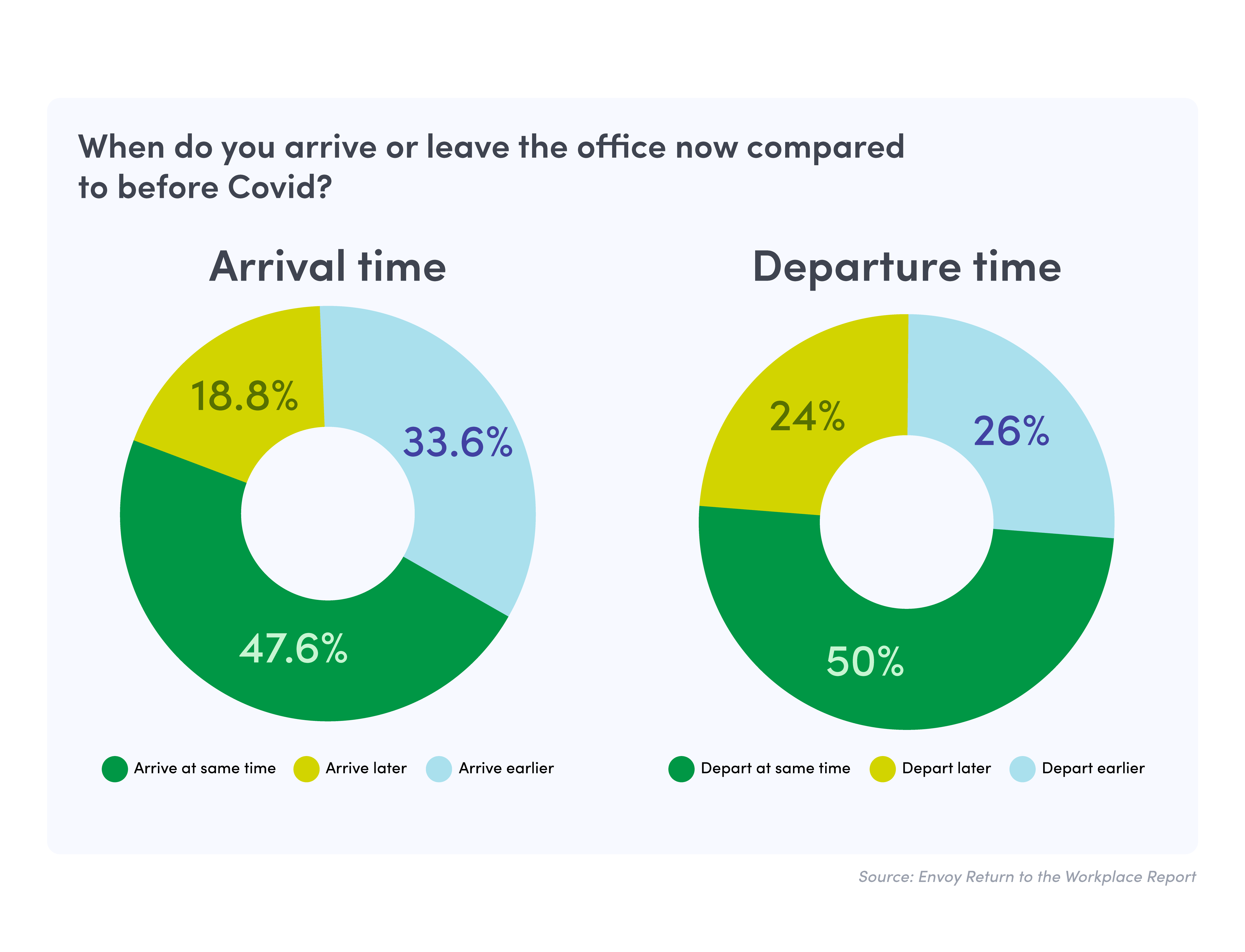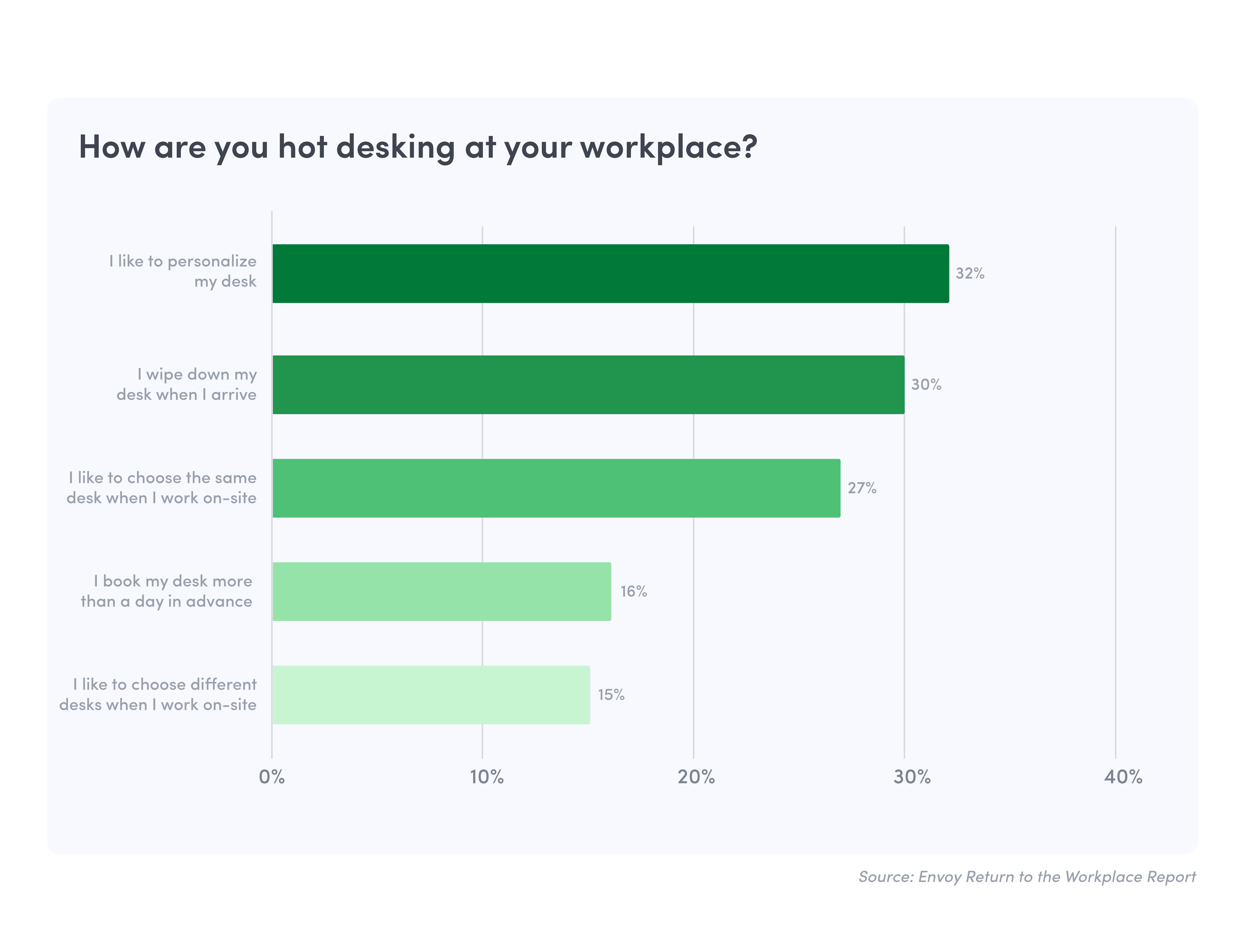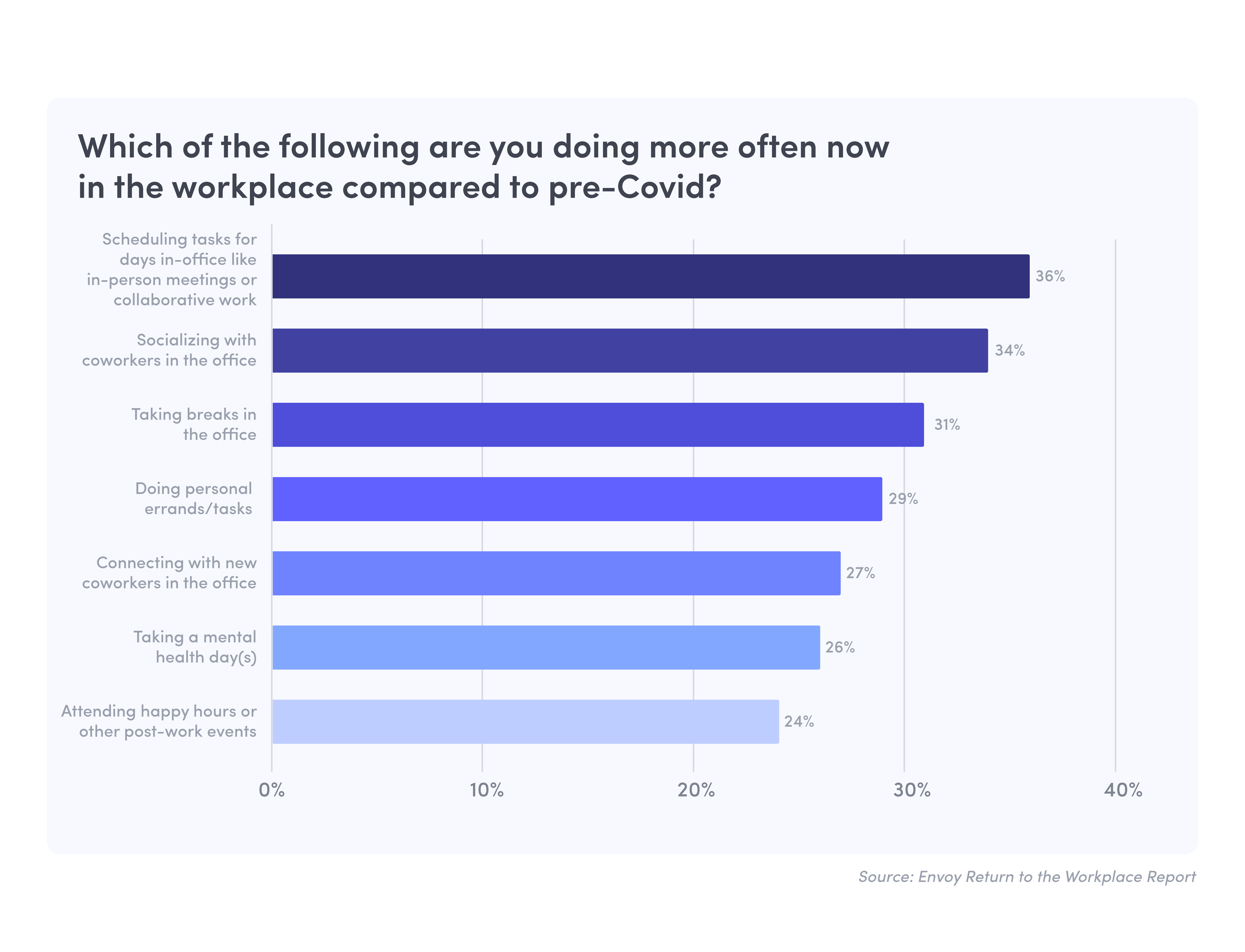Old habits die hard. That is, until a pandemic. The way we work, interact, and communicate in the workplace has been turned on its head. In the latest Return to the Workplace report, we asked 1,000 office workers which workplace habits they’ve changed since Covid—and which have stayed the same. Not a surprise, they had a lot to say. Folks are setting aside old routines and attitudes in favor of new ones. And, they’re also reassessing how they spend their time in the workplace. Of the 1,000 office workers that we surveyed:
- 63% have a mandatory in-office policy, while 37% come in voluntarily
- 60% are hybrid and 40% work full-time in the workplace
- Over half returned 7-12 months ago; 36% came back 4-6 months ago; and only 12% returned within the past month to 3 months
Here are the top ways behaviors and attitudes are shifting:
People are making the most of office life—and it’s better than expected
When it comes to the return, employers and employees have feared the worst for so long. But attitudes are shifting: most (90%) are discovering that being back isn’t what they anticipated—in fact, it’s better. Even among those required to return, there’s consensus (91%) that the return is better than expected. And showing up has its own rewards. According to our survey earlier this year, people are most excited to meet up with work friends in the workplace, to get out of the house, and to collaborate in-person.
Folks aren't sticking to the old 9 to 5 schedule
A little over half (52%) of employees have switched up their pre-pandemic commute to the office. Office hours have shifted earlier. Over a third (34%) are coming in earlier than they did before Covid and about a quarter (26%) are taking off earlier.

35% of workers surveyed changed jobs during the pandemic, which could explain the shift in commute patterns. New hires are staying longer at the office compared to their more tenured co-workers: 41% are arriving earlier and 31% are leaving later.We also took a look at those returning to the same pre-Covid job. Among this segment, old commuting habits are hard to break. On average, those returning to the same job are sticking to tried and true routines. 57% arrive and 60% leave the office at their usual pre-pandemic time. Even travel time has remained fairly consistent with 67% confessing to no change.
Employees like to choose the same desk when onsite—and even more prefer to personalize that desk
77% of companies have adopted a hybrid working model with hot desking. It’s a great way for companies to flex workspace and be as efficient as possible, while also meeting on-demand desk needs. 78% of those we surveyed have the option to reserve desks in advance. More than a quarter (27%) prefer to choose the same desk when working on-site. Only 15% prefer to mix it up.

One reason why folks may prefer the same desk is a desire to have a space of their own. Nearly a third (32%) prefer to customize temporary desks with ergonomic chairs, a favorite keyboard, or items from home. Customization is a particular favorite with Millennials: 40% enjoy personalizing their desk space compared to only 21% of Gen X and 34% of Gen Z.
Time management tops the list of skills employees are re-learning
As humans we’re built to connect with others face-to-face—and the skills to do this well are rarely innate. They take practice. 86% of those we surveyed have rebooted essential skills that have gone dormant while working from home. And some even admit the need to work on new competencies now that they’re back. When we asked about what skills folks are brushing up on:
- Time management took the number one spot at 40%
- 31% say they’re rusty when it comes to small talk and interacting with others
- 29% are practicing in-person presentation skills
- Picking out the right work outfit after two years of elastic waistbands also ranks high on the refresh list (29%)
- 28% are re-learning how to maintain good body posture after so much time at home
People are spending more time on Zoom with coworkers who aren’t in the office
Catching coworkers in-person is tough. Even with thoughtful planning like reserving meetings for when you’re in the office. Nearly half (49%) of employees in the workplace spend more time than they did pre-pandemic in virtual meetings with colleagues not on-site. 49% also say they’re emailing more. Only 37% spend more time talking to coworkers IRL.
Employees are planning their days in-office as they see fit
Folks are feeling more empowered to switch up their routine since the pandemic. Nearly all (93%) are planning their work days as they see fit, blending in downtime in the form of personal breaks or social activity. Or they are planning specific tasks for office days. More than a third (36%) say they prefer to reserve priority meetings and collaborative work for days onsite.

Taking more purposeful breaks while at the office (31%) and running personal errands (29%) are priorities for nearly a third of employees—especially men. They’re more likely than women to take needed breaks during the workday or run personal errands. Mental well-being is also top of mind, especially for Gen Z. These younger workers are more inclined than any other generation to take a mental health day (or two).Workers are also making more space in their schedules to socialize—more so than before Covid. 34% are hanging out more with coworkers in the office. 27% are making the effort to meet new folks at work and nearly a quarter (24%) are attending more happy hours or other post-work events. Folks are making the most of workplace life. They’re getting to know the people they work with. They’re proactively scheduling collaboration time, choosing that preferred desk, or taking more breaks at the office. All in all, they’re making that commute worthwhile by finding value again in the workplace.
About This Survey
Envoy partnered with Wakefield Research to survey 1,000 U.S. office workers who have “returned” to the workplace. "Returned" is defined as those working from the workplace at least 1 full day per week and returned in the last 12 months, but not within the last 30 days. Survey responses were collected between May 12 and May 22, 2022, using an email invitation and online survey. Quotas were set to ensure an accurate representation of U.S. office workers who have returned to the workplace. The overall margin of error for the findings is ±3.1% at a 95% confidence level.
Read more
Searching for a visitor management solution? Learn what to look out for and how to choose the best tech for your team.
Managing your space well doesn’t have to be difficult. But if you want to be successful, you need the right approach.
A well-run workplace can set your team up for success. Learn why workplace management matters and how to do it right.
Workplace security is critical to the future of your business. Learn why it matters, what threats to watch for, and how to strengthen your workplace security plan.
In this post, we’ll explore what workplace compliance is and how to build a compliance culture for your organization.
With more folks sending personal packages to the workplace, having a sound mailroom management system in place is key.










